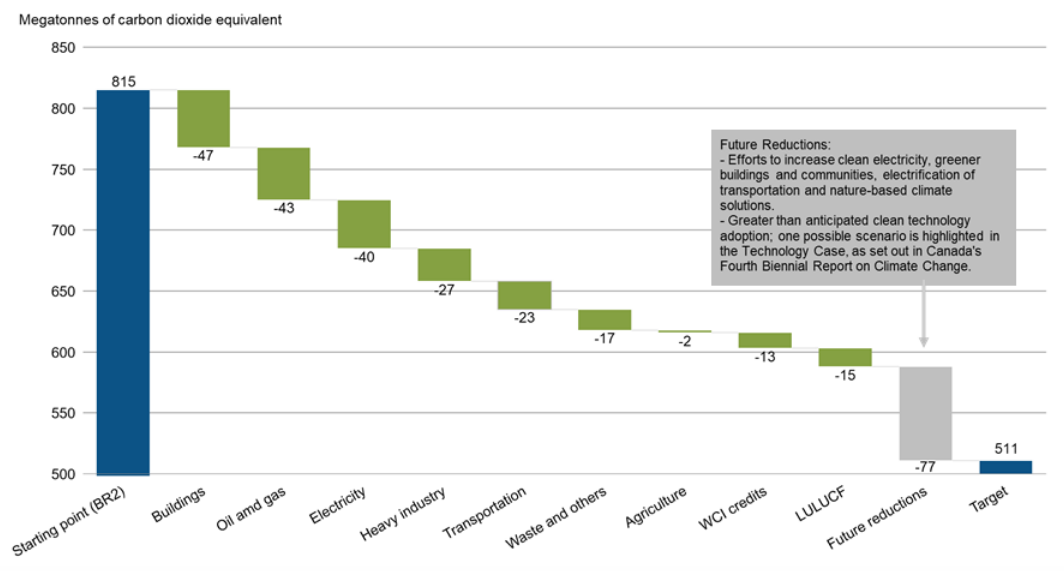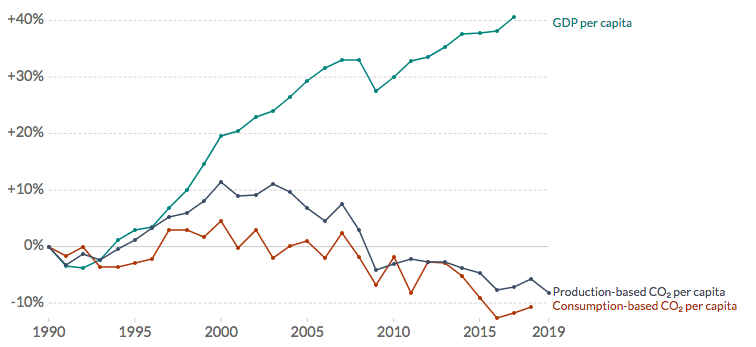The earth is on course for an average temperature increase of 3–4°C by 2100 unless CO2 emissions are reduced. Global warming of this magnitude will result in substantial human migration, regional conflicts over increasingly scarce resources, and extreme weather events, causing devastating physical damages and economic costs. While the sense of urgency to address global warming is apparent, the question remains, is enough being done in Canada?
The 2015 Paris Agreement set goals for nations to reduce their greenhouse gas (GHG) emissions significantly by 2030, with the goal of reaching “net zero” emissions by 2050. To meet the objective of the Paris Agreement, the Intergovernmental Panel on Climate Change suggests that, in order to transition to a global low carbon economy, capital investment of between USD 1.6 and 3.8 trillion annually would be required for the new energy systems alone.[1]
In Canada, the federal government committed to reducing greenhouse gas (GHG) emissions by 30% below 2005 levels by 2030, while aiming to become carbon neutral by 2050. As a first step towards implementing the commitments, on December 9, 2016, Canada’s First Ministers introduced a Pan-Canadian Framework on Clean Growth and Climate Change. Under this framework, there has been an acceleration of initiatives put in place by federal, provincial and municipal governments to reinforce their commitment to carbon neutrality. These include legislation like the Greenhouse Gas Pollution Pricing Act which aims to set a price on carbon emissions and a CAD $2 billion Low Carbon Economy Fund to support projects that are reducing GHG emissions; a program that the City of Toronto is taking advantage of to reduce emissions from ambulances and emergency paramedic response units.
The federal government’s long-term infrastructure plan also committed to CAD $55 billion over the next decade on green infrastructure and public transit projects. More recently, in November 2020, the Minister of Environment and Climate Change, the Honourable Jonathan Wilkinson, delivered a commitment to legislate the Canadian Net-Zero Emissions Accountability Act with a current intention to increase disclosure and transparency of the government’s progress on delivering to net zero.
These initiatives are bringing Canada closer to the 2030 commitment with a gap of 77 Mega tonnes of carbon dioxide equivalent left to account for.
Contributions to emissions reductions by 2030 [2]
 Source: Government of Canada, Environment and Climate Change: Progress Towards Canada’s Greenhouse Gas Emissions, 2019
Source: Government of Canada, Environment and Climate Change: Progress Towards Canada’s Greenhouse Gas Emissions, 2019
In addition, over the last two decades, Canada has made progress in “decoupling” its GDP growth from its CO2 emissions – a necessary development in order to achieve targets without adversely impacting the economy.
Change in per capita – CO2 emissions and GDP, Canada

Source: https://ourworldindata.org/co2/country/canada?country=~CAN
With encouraging progress in Canada and globally, there are several challenges that still need to be addressed by governments. For one, a meaningful investment and consideration is required for the millions of jobs that are employed by the energy sector (globally 58 million, with about half in fossil fuel industries). A reskilling or upskilling is critical to ensuring the existing workforce is not disadvantaged by the transition. Secondly, Canada’s contribution to change is limited to its 2% contribution of global CO2 emissions. The leading countries that can make a significant contribution to climate change are China, contributing about 28%, and the US, contributing about 15%. A more concentrated focus is required in high emitting countries to meet the Paris Agreement. Thirdly, and perhaps the most critical part of this journey is ensuring governments remain on course and aligned to the targets, regardless of the political party or faction that is in power. Perhaps the most dramatic turn was witnessed more recently in the US when President Trump took office only to withdraw the US from the Paris Agreement; and in Canada this misalignment is evident between the federal and provincial governments as they push varying agendas with different degrees of urgency. Some segments of the population either do not feel the urgency of global warming or perhaps are too economically dependent on traditional energy sources to see the urgency of accelerating their transition.
While there is much focus on governmental commitments, investors and corporations have a critical role to meeting the Paris Agreement. In 2019, a group of 33 of the world’s largest asset owners formed the UN-convened Net-Zero Asset Owner Alliance committed to reducing carbon emissions in their portfolios, worth over US $5.1 trillion, to net-zero by 2050. A year later, the Net-Zero Asset Manager Alliance launched with 30 founding signatories and about US $9 trillion in assets. Alliances and investor networks are important to aligning and uniting the priorities of the investment industry and have a tremendous impact in moving all sectors, both public and private.
One of the benefits of such investor networks is promoting and requiring standardized disclosures, such as aligning to the Taskforce for Climate-related Financial Disclosures, which is foundational to enabling investment managers to assess and integrate the risk of climate change across their holdings and portfolios. As more asset owners and managers join such alliances to enhance their assessment of climate risks, it could have a meaningful impact on the cost of capital for companies which will serve as a motivation to align to the Paris Agreement. With such a broad reach, the investment management industry needs to work closely with governments to lead this change.
As UN Secretary-General António Guterres said at an action event, “We are dealing with scientific facts, not politics. And the facts are clear. Climate change is a direct threat in itself, and a multiplier of many other threats.” This is a global problem, and while challenges will be faced through this transition, it nevertheless must be a priority for every government, corporation and individual. For now, Canada and the Canadian investment industry are making meaningful progress on the journey towards a greener economy but there is a long road ahead.
Sources:
[1] IPCC, 2018: Global Warming of 1.5°C.An IPCC Special Report on the impacts of global warming of 1.5°C above pre-industrial levels and related global greenhouse gas emission pathways, in the context of strengthening the global response to the threat of climate change, sustainable development, and efforts to eradicate poverty [Masson-Delmotte, V., P. Zhai, H.-O. Pörtner, D. Roberts, J. Skea, P.R. Shukla, A. Pirani, W. Moufouma-Okia, C. Péan, R. Pidcock, S. Connors, J.B.R. Matthews, Y. Chen, X. Zhou, M.I. Gomis, E. Lonnoy, T. Maycock, M. Tignor, and T. Waterfield (eds.)]. In Press.
[2] Government of Canada, Environment and Climate Change: Progress Towards Canada’s Greenhouse Gas Emissions, 2019



